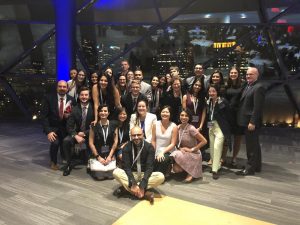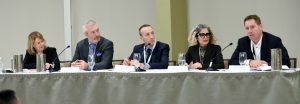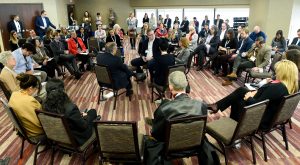Aileen Gracias is a Technology Analyst at CCRM where she leads technology sourcing, conducts diligence and participates in company creation efforts to support incubation activities. Prior to joining CCRM, Aileen was a Postdoctoral Fellow in Molly Shoichet’s Lab. Aileen has a background in neuro-oncology with a PhD from Karolinska Institute, Sweden, and a BSc in Biochemistry and Toxicology from the University of Toronto.
In its 11th year, the Canadian Science Policy Conference (CSPC) welcomed policy makers, scientists, entrepreneurs, politicians, journalists, trainees and other academic and industry professionals to Ottawa from November 13-15 to share thoughts and reflect on the current state of Canadian science, technology and innovation policy.
CSPC is organized by the Canadian Science Policy Centre and its more than 60 volunteers. I had the pleasure to participate on the grant writing committee. It was an extremely rewarding experience working with and learning from this dynamic group of individuals representing different scientific backgrounds and exploring a field outside our comfort zone (for some of us at least).
The conference kicked off with the Policy 101 session, which was very insightful for newbies like myself. Mehrdad Hariri, President and CEO of CSPC, highlighted current trends in science policy. He discussed upgrading scientific research funding mechanisms through investment in scientific research, the culture of evidence-based decision making and the national campaign on equity, diversity and inclusion.
Canada produced 3.8 per cent of the world’s research and 1 per cent of global patents indicating it is lagging in R&D investment. However, as of the 2018 federal budget, there has been a 35 per cent increase in research investment.
A panel organized by FACIT, an Ontario accelerator focused on oncology innovations, shed light on Ontario’s attempts to drive the life science innovation commercialization ecosystem through public-private partnerships. In early 2019, FACIT and one of its portfolio companies, Triphase Accelerator, announced a US$1B partnership with Celgene for a blood cancer therapy discovered by an OICR team led by Rima Al-awar.
According to the panelists, Canadian universities spend approximately $7B in research and recover approximately $80M in revenue. This low return does not reflect the outstanding scientific potential in the country and calls for organizations to prioritize economic return to Canada. The take home message was that the public sector should provide more support to startups, or else these startups will seek support elsewhere. This will have a negative impact on the Canadian job market, research and innovation and, ultimately, health care for patients.
The importance of global relationships in an innovation economy was the theme for the panel organized by Ryerson University. Emmanuel Kamarianakis, Global Affairs Canada, explained that the biggest challenge startups face is scaling up. Roger Scott-Douglas, National Research Council Canada, reiterated the importance of individual relationships in building collaborations that can eventually contribute to the innovation and commercialization sector.
One of the most intriguing panels was titled “The Promise of Science and its Implications for Science Policy: Perspectives of Canada’s Science Technology and Innovation Community,” organized by Amy Lemay, Vista Science & Technology. This interactive Fishbowl panel included representatives from Genome Canada, Acadia University, Genome BC and the Globe & Mail.
This session addressed some of the gaps in science policy including the lack of awareness of the scientific process amongst the general public, educating the public on reliable sources and generally reinforcing the public’s trust in science through data standardization. Alice Cohen, Acadia University, stressed that policy makers require data to act and that the only way to affect change is to get the data right. She said data standardization is crucial in this process.
Mona Nemer, Canada’s Chief Science Advisor, was interviewed about her past year’s performance. Her main message was to urge the audience to engage more with the public.
This conference was extremely enriching and helped develop a lot of insights around the present and future of science policy. Besides being inspired by the panelists, I was introduced to key organizations that help young professionals dive into the world of science policy and its societal impacts. For example, there is Science Outside the Lab (SOTL) and Science Policy Exchange (SPE) that help bridge the gap between academia, industry and government to inspire evidence-based policy-making.
Rolf Heur, Chair of the European Commission’s Group of Scientific Advisors said, “Excellence requires competition and collaboration.” We need to leverage our talents and network across the country and globally to contribute to improving Canada’s life science commercialization ecosystem to strive for better patient care.
Guest
Latest posts by Guest (see all)
- Regenerative immunotherapy: Hope for chronic autoimmune diseases - September 16, 2025
- Canada’s regenerative revolution: Why AI is the catalyst - September 4, 2025
- Summer by Design: A launchpad for future entrepreneurs and industry scientists - August 14, 2025









Comments